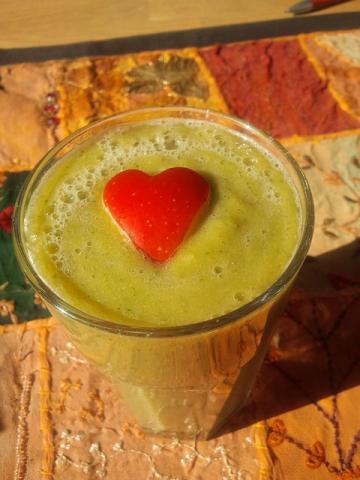
We have all heard of the juice cleanse, green juice, juiceries and so on. Juicing is so mainstream now that one can find pressed, organic juices readily available in any major chain grocery. In fact, there are a plentiful number of businesses that only sell juice and they are doing well in the marketplace. This commercial success usually means a quelling of the buzz amongst the more dedicated “health nuts.” So, I feel that it is finally safe for me to come out as a (gasp) “Smoothier.”
I used to juice daily and I loved it. However, once I got turned on to smoothies, friends, I simply could no longer opt for its waterier cousin. Yes, that’s right. I do not juice. It’s not that freshly made juices are not good for you. They certainly are. They deliver tons of nutrients, phytos and other good-for-you things that are condensed down into a delicious, easy to absorb glassful. Rather, it’s what isn’t there (among several other key factors) that has me saying, “Good Morning!” to the ear-shattering rumble of my high-powered blender. Before I get into what juice is “missing” for me, let me preface this by acknowledging that juice, bar none ,will give you more nutrients. That is a simple mathematical reality – you are able to put more produce into a reasonable serving, and thus you will get more nutrients. This is, of course, a wonderful thing! However, if you are eating a whole food, plant-based diet already and are not suffering from chronic disease, hear me out on this smoothie thing.
What juicing is missing for me is all the fiber! In fact, according to Joe Cross, the man who famously lived on juice on film, when you juice, you lose up to 30% of the fruit or vegetable. That 30% is insoluble fiber. Why should you care about insoluble fiber? Well, to understand that, we first need to understand the difference between insoluble and soluble fiber. Both are essential for good health, proper digestion, and disease prevention. Here is how they break down according to the National Institute for Health.
-Soluble fiber attracts water and turns to gel during digestion. This slows digestion. Soluble fiber is found in oat bran, barley, nuts, seeds, beans, lentils, peas, and some fruits and vegetables. It is also found in psyllium, a common fiber supplement. Some types of soluble fiber may help lower risk of heart disease
-Insoluble fiber is found in foods such as wheat bran, vegetables, and whole grains. It adds bulk to the stool and appears to help food pass more quickly through the stomach and intestines. 12
With our bodies doing battle with so many toxins, it makes little sense to do away with nature’s broom. We need to move food through our bodies to cleanse our innards and frankly, to avoid dreaded belly bloat and constipation. You see, a juice cleanse isn’t necessary if you are regularly sweeping out your insides. By keeping fruits and vegetables in their most “whole” state, you are naturally aiding your body in its given ability to cleanse itself.
Still not convinced? Take a look at my other top 5 reasons for choosing smoothies over juices:
1.It’s faster: No cutting up of fruits or veggies, no bundling up of greens. Just throw it all in there and voila! Clean up takes one minute exactly. Put soap and water into your blender, put on high for 60 seconds and voila! It’s clean.
2.Keep it Cool: Unless you are using a slow juicer, the heat from a centrifugal juicer causes faster oxidation of nutrients. This means that to receive all the benefits from your juice you have to down it in 15 minutes. As long as you add plenty of ice to your blender and avoid blending for an unnecessary amount of time, you will not experience this with smoothies as quickly.
3.Add it in: I add in tons of superfoods to my smoothies in addition to the fruits and veggies themselves. Try spirulina, cacao, coconut oil, flax meal, chia and more! You can blend all of this smooth and maximize your nutrition.
4.Sustained energy: Juices do not keep you full. This is due to the removal of the insoluble fiber. However, a smoothie on the go can hold you over for hours. Additionally, the inclusion of the fiber ensures a slower absorption of the sugar. This is essential for sustained energy. With juices, since you are rapidly absorbing them into your body, you will experience immediate but short-lived bursts of energy.
5.Calories: Since you are not removing the fiber, smoothies are giving you a much lower calorie-per-volume ratio than juices. While this is of course a double-edged sword in that there are fewer nutrients, do you really need 6 beets?
So, don’t shy away from smoothies! Aim for a ⅓ fruit and ⅔ vegetable ratio as you start on your smoothie journey. As you adjust to enjoying grassier flavors, increase your vegetables and slowly decrease your fruit. This will ensure you are enjoying a low sugar smoothie full of vibrant vegetables. Give smoothies a try as a break from your normal juice routine. You may find you experience improved digestion and longer satiation. In this high stress, busy world, they may provide you the speed and nutrition you crave.
1. Lembo AJ, Ullman SP. Constipation. In: Feldman M, Friedman LS, Sleisenger MH, eds.Sleisenger & Fordtran's Gastrointestinal and Liver Disease. 9th ed. Philadelphia, PA: Elsevier Saunders; 2010:chap 18.
2. Threapleton DE, Greenwood DC, Evans CEL, et al. Dietary fibre intake and risk of cardiovascular disease: systematic review and meta-analysis. BMJ. 2013;347:f6879.








